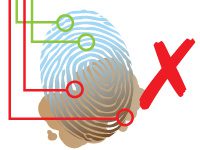
Hollywood isn’t exactly known for accuracy, and their portrayal of biometric technology is no exception. Fingerprint scanners, facial recognition software, and iris recognition technology have become commonplace in thrillers and crime films to create suspense and high-tech futuristic scenes. But they just don’t have the facts right—in some cases, overestimating the capabilities of biometric technologies, and in other cases selling it short.
Let’s start with the basics: biometrics is the science of identifying people based on human characteristics and attributes.

Fingerprint
In espionage films, fingerprint scanners seem to be everywhere. While these systems may appear cutting edge, their functionality isn’t as practical as filmmakers would have us believe. For example, when the secret agent rushes out of headquarters holding an illegally obtained computer chip and quickly swipes his thumb over a scanner, he’d better hope that he doesn’t have any pizza grease from lunch on his hands or newly acquired scars from working in the field. These flaws are picked up by scanners and can change the configuration of a fingerprint.
Even with clean, uninjured hands, the agent’s escape would still be relatively slow. In a high-security location with a large database, the scanner would likely require authentication of up to all 10 fingers. By then, the bad guys would have caught up with our hero.

Facial Recognition
Another common misrepresentation is the use of facial recognition software to find a criminal hiding in a crowd. In these scenes, the police scan security footage and almost instantly identify the suspect. If this scenario seems a little too good to be true, that’s because it is.
Facial recognition is not nearly as fast and automated as in the movies. It is dependent on algorithms that match an isolated facial image with an existing one, like a mug shot, driver’s license, or passport. Seemingly subtle variants can throw off the system—including lighting conditions, significant distances, moving angles, and facial expressions, hairstyles, hats, and glasses. Therefore, it can be very difficult to find an image that has the correct conditions.

Iris Recognition
Iris recognition technology is actually more advanced than systems typically depicted on screen. In films, we often see actors lean close to the scanners, practically placing their eyes on the screen. Then they stand perfectly still and wait patiently for identification.
In reality, current iris recognition technology can identify users in less than a second from up to 10 feet away—thanks to advancements in capture technology. SRI’s biometric systems use our patented illumination process to capture accurate iris images—even while a user is moving or wearing contact lenses or glasses.
Hollywood producers should take notice. When it comes to iris recognition, the truth is more exciting than fiction.


